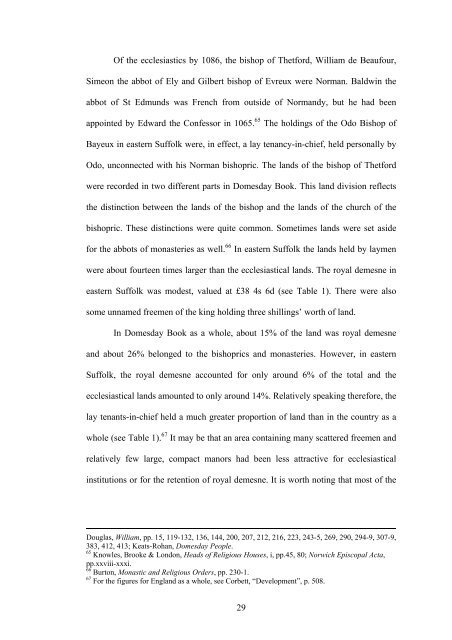I certify that I have read this thesis and have ... - Bilkent University
I certify that I have read this thesis and have ... - Bilkent University
I certify that I have read this thesis and have ... - Bilkent University
You also want an ePaper? Increase the reach of your titles
YUMPU automatically turns print PDFs into web optimized ePapers that Google loves.
Of the ecclesiastics by 1086, the bishop of Thetford, William de Beaufour,<br />
Simeon the abbot of Ely <strong>and</strong> Gilbert bishop of Evreux were Norman. Baldwin the<br />
abbot of St Edmunds was French from outside of Norm<strong>and</strong>y, but he had been<br />
appointed by Edward the Confessor in 1065. 65 The holdings of the Odo Bishop of<br />
Bayeux in eastern Suffolk were, in effect, a lay tenancy-in-chief, held personally by<br />
Odo, unconnected with his Norman bishopric. The l<strong>and</strong>s of the bishop of Thetford<br />
were recorded in two different parts in Domesday Book. This l<strong>and</strong> division reflects<br />
the distinction between the l<strong>and</strong>s of the bishop <strong>and</strong> the l<strong>and</strong>s of the church of the<br />
bishopric. These distinctions were quite common. Sometimes l<strong>and</strong>s were set aside<br />
for the abbots of monasteries as well. 66 In eastern Suffolk the l<strong>and</strong>s held by laymen<br />
were about fourteen times larger than the ecclesiastical l<strong>and</strong>s. The royal demesne in<br />
eastern Suffolk was modest, valued at £38 4s 6d (see Table 1). There were also<br />
some unnamed freemen of the king holding three shillings’ worth of l<strong>and</strong>.<br />
In Domesday Book as a whole, about 15% of the l<strong>and</strong> was royal demesne<br />
<strong>and</strong> about 26% belonged to the bishoprics <strong>and</strong> monasteries. However, in eastern<br />
Suffolk, the royal demesne accounted for only around 6% of the total <strong>and</strong> the<br />
ecclesiastical l<strong>and</strong>s amounted to only around 14%. Relatively speaking therefore, the<br />
lay tenants-in-chief held a much greater proportion of l<strong>and</strong> than in the country as a<br />
whole (see Table 1). 67 It may be <strong>that</strong> an area containing many scattered freemen <strong>and</strong><br />
relatively few large, compact manors had been less attractive for ecclesiastical<br />
institutions or for the retention of royal demesne. It is worth noting <strong>that</strong> most of the<br />
Douglas, William, pp. 15, 119-132, 136, 144, 200, 207, 212, 216, 223, 243-5, 269, 290, 294-9, 307-9,<br />
383, 412, 413; Keats-Rohan, Domesday People.<br />
65<br />
Knowles, Brooke & London, Heads of Religious Houses, i, pp.45, 80; Norwich Episcopal Acta,<br />
pp.xxviii-xxxi.<br />
66<br />
Burton, Monastic <strong>and</strong> Religious Orders, pp. 230-1.<br />
67<br />
For the figures for Engl<strong>and</strong> as a whole, see Corbett, “Development”, p. 508.<br />
29
















